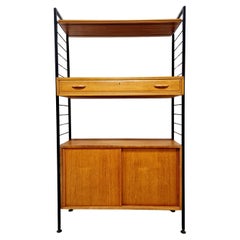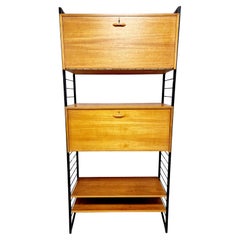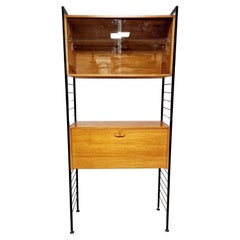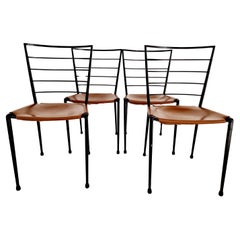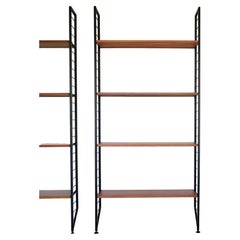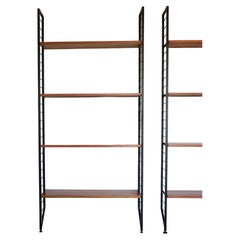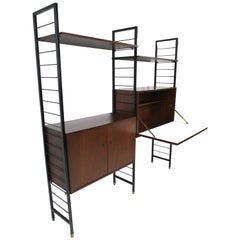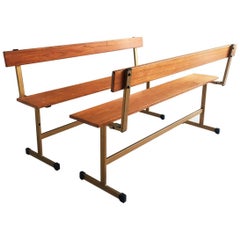Vintage Ladderax Furniture
Mid-20th Century British Mid-Century Modern Vintage Ladderax Furniture
Teak
Mid-20th Century British Mid-Century Modern Vintage Ladderax Furniture
Teak
Mid-20th Century British Mid-Century Modern Vintage Ladderax Furniture
Teak
Mid-20th Century British Mid-Century Modern Vintage Ladderax Furniture
Metal
Mid-20th Century British Mid-Century Modern Vintage Ladderax Furniture
Metal
Mid-20th Century British Mid-Century Modern Vintage Ladderax Furniture
Metal
Mid-20th Century Unknown Mid-Century Modern Vintage Ladderax Furniture
Brass, Steel
Recent Sales
1960s Great Britain (UK) Mid-Century Modern Vintage Ladderax Furniture
Metal
Mid-20th Century English Vintage Ladderax Furniture
Teak
Mid-20th Century British Mid-Century Modern Vintage Ladderax Furniture
Teak
Mid-20th Century British Mid-Century Modern Vintage Ladderax Furniture
Teak
1960s English Vintage Ladderax Furniture
Teak
Mid-20th Century British Mid-Century Modern Vintage Ladderax Furniture
Metal
1960s English Vintage Ladderax Furniture
Teak
1960s English Mid-Century Modern Vintage Ladderax Furniture
Teak
1960s English Vintage Ladderax Furniture
Teak
Mid-20th Century English Mid-Century Modern Vintage Ladderax Furniture
Wood
Mid-20th Century British Mid-Century Modern Vintage Ladderax Furniture
Teak
Mid-20th Century British Mid-Century Modern Vintage Ladderax Furniture
Metal
Mid-20th Century British Mid-Century Modern Vintage Ladderax Furniture
Metal
1960s British Mid-Century Modern Vintage Ladderax Furniture
Metal
1960s British Mid-Century Modern Vintage Ladderax Furniture
Metal
20th Century English Mid-Century Modern Vintage Ladderax Furniture
Steel
Mid-20th Century English Mid-Century Modern Vintage Ladderax Furniture
Teak
Mid-20th Century English Mid-Century Modern Vintage Ladderax Furniture
Metal
1960s British Mid-Century Modern Vintage Ladderax Furniture
Metal
1960s British Mid-Century Modern Vintage Ladderax Furniture
Metal
1960s British Mid-Century Modern Vintage Ladderax Furniture
Metal
1960s British Mid-Century Modern Vintage Ladderax Furniture
Metal
1960s British Mid-Century Modern Vintage Ladderax Furniture
Teak
1960s British Mid-Century Modern Vintage Ladderax Furniture
Metal
1960s British Mid-Century Modern Vintage Ladderax Furniture
Metal
1960s British Mid-Century Modern Vintage Ladderax Furniture
Metal
1960s English Mid-Century Modern Vintage Ladderax Furniture
Teak
Mid-20th Century British Mid-Century Modern Vintage Ladderax Furniture
Teak
Mid-20th Century English Mid-Century Modern Vintage Ladderax Furniture
Metal
Mid-20th Century English Mid-Century Modern Vintage Ladderax Furniture
Teak
1960s British Mid-Century Modern Vintage Ladderax Furniture
Teak
1960s British Mid-Century Modern Vintage Ladderax Furniture
Metal
Mid-20th Century British Mid-Century Modern Vintage Ladderax Furniture
Wood
1960s English Mid-Century Modern Vintage Ladderax Furniture
Teak
Mid-20th Century English Mid-Century Modern Vintage Ladderax Furniture
Teak
1960s English Mid-Century Modern Vintage Ladderax Furniture
Metal
Mid-20th Century British Mid-Century Modern Vintage Ladderax Furniture
Metal
1960s English Mid-Century Modern Vintage Ladderax Furniture
Teak
Mid-20th Century British Mid-Century Modern Vintage Ladderax Furniture
Metal
Mid-20th Century British Mid-Century Modern Vintage Ladderax Furniture
Metal
1960s British Mid-Century Modern Vintage Ladderax Furniture
Teak
1960s British Vintage Ladderax Furniture
Metal
Mid-20th Century Danish Mid-Century Modern Vintage Ladderax Furniture
Steel
1960s British Mid-Century Modern Vintage Ladderax Furniture
Metal
Mid-20th Century Vintage Ladderax Furniture
1970s British Mid-Century Modern Vintage Ladderax Furniture
Mid-20th Century British Mid-Century Modern Vintage Ladderax Furniture
Metal
Mid-20th Century British Mid-Century Modern Vintage Ladderax Furniture
Metal
Mid-20th Century British Mid-Century Modern Vintage Ladderax Furniture
Metal
Mid-20th Century British Mid-Century Modern Vintage Ladderax Furniture
Metal
A Close Look at Mid-century-modern Furniture
Organically shaped, clean-lined and elegantly simple are three terms that well describe vintage mid-century modern furniture. The style, which emerged primarily in the years following World War II, is characterized by pieces that were conceived and made in an energetic, optimistic spirit by creators who believed that good design was an essential part of good living.
ORIGINS OF MID-CENTURY MODERN FURNITURE DESIGN
- Emerged during the mid-20th century
- Informed by European modernism, Bauhaus, International style, Scandinavian modernism and Frank Lloyd Wright’s architecture
- A heyday of innovation in postwar America
- Experimentation with new ideas, new materials and new forms flourished in Scandinavia, Italy, the former Czechoslovakia and elsewhere in Europe
CHARACTERISTICS OF MID-CENTURY MODERN FURNITURE DESIGN
- Simplicity, organic forms, clean lines
- A blend of neutral and bold Pop art colors
- Use of natural and man-made materials — alluring woods such as teak, rosewood and oak; steel, fiberglass and molded plywood
- Light-filled spaces with colorful upholstery
- Glass walls and an emphasis on the outdoors
- Promotion of functionality
MID-CENTURY MODERN FURNITURE DESIGNERS TO KNOW
- Charles and Ray Eames
- Eero Saarinen
- Milo Baughman
- Florence Knoll
- Harry Bertoia
- Isamu Noguchi
- George Nelson
- Danish modernists Hans Wegner and Arne Jacobsen, whose emphasis on natural materials and craftsmanship influenced American designers and vice versa
ICONIC MID-CENTURY MODERN FURNITURE DESIGNS
- Eames lounge chair
- Nelson daybed
- Florence Knoll sofa
- Egg chair
- Womb chair
- Noguchi coffee table
- Barcelona chair
VINTAGE MID-CENTURY MODERN FURNITURE ON 1STDIBS
The mid-century modern era saw leagues of postwar American architects and designers animated by new ideas and new technology. The lean, functionalist International-style architecture of Le Corbusier and Bauhaus eminences Ludwig Mies van der Rohe and Walter Gropius had been promoted in the United States during the 1930s by Philip Johnson and others. New building techniques, such as “post-and-beam” construction, allowed the International-style schemes to be realized on a small scale in open-plan houses with long walls of glass.
Materials developed for wartime use became available for domestic goods and were incorporated into mid-century modern furniture designs. Charles and Ray Eames and Eero Saarinen, who had experimented extensively with molded plywood, eagerly embraced fiberglass for pieces such as the La Chaise and the Womb chair, respectively.
Architect, writer and designer George Nelson created with his team shades for the Bubble lamp using a new translucent polymer skin and, as design director at Herman Miller, recruited the Eameses, Alexander Girard and others for projects at the legendary Michigan furniture manufacturer.
Harry Bertoia and Isamu Noguchi devised chairs and tables built of wire mesh and wire struts. Materials were repurposed too: The Danish-born designer Jens Risom created a line of chairs using surplus parachute straps for webbed seats and backrests.
The Risom lounge chair was among the first pieces of furniture commissioned and produced by celebrated manufacturer Knoll, a chief influencer in the rise of modern design in the United States, thanks to the work of Florence Knoll, the pioneering architect and designer who made the firm a leader in its field. The seating that Knoll created for office spaces — as well as pieces designed by Florence initially for commercial clients — soon became desirable for the home.
As the demand for casual, uncluttered furnishings grew, more mid-century furniture designers caught the spirit.
Classically oriented creators such as Edward Wormley, house designer for Dunbar Inc., offered such pieces as the sinuous Listen to Me chaise; the British expatriate T.H. Robsjohn-Gibbings switched gears, creating items such as the tiered, biomorphic Mesa table. There were Young Turks such as Paul McCobb, who designed holistic groups of sleek, blond wood furniture, and Milo Baughman, who espoused a West Coast aesthetic in minimalist teak dining tables and lushly upholstered chairs and sofas with angular steel frames.
Generations turn over, and mid-century modern remains arguably the most popular style going. As the collection of vintage mid-century modern chairs, dressers, coffee tables and other furniture for the living room, dining room, bedroom and elsewhere on 1stDibs demonstrates, this period saw one of the most delightful and dramatic flowerings of creativity in design history.
Finding the Right Storage-case-pieces for You
Of all the vintage storage cabinets and antique case pieces that have become popular in modern interiors over the years, dressers, credenzas and cabinets have long been home staples, perfect for routine storage or protection of personal items.
In the mid-19th century, cabinetmakers would mimic styles originating in the Louis XIV, Louis XV and Louis XVI eras for their dressers, bookshelves and other structures, and, later, simpler, streamlined wood designs allowed these “case pieces” or “case goods” — any furnishing that is unupholstered and has some semblance of a storage component — to blend into the background of any interior.
Mid-century modern furniture enthusiasts will cite the tall modular wall units crafted in teak and other sought-after woods of the era by the likes of George Nelson, Poul Cadovius and Finn Juhl. For these highly customizable furnishings, designers of the day delivered an alternative to big, heavy bookcases by considering the use of space — and, in particular, walls — in new and innovative ways. Mid-century modern credenzas, which, long and low, evolved from tables that were built as early as the 14th century in Italy, typically have no legs or very short legs and have grown in popularity as an alluring storage option over time.
Although the name immediately invokes images of clothing, dressers were initially created in Europe for a much different purpose. This furnishing was initially a flat-surfaced, low-profile side table equipped with a few drawers — a common fixture used to dress and prepare meats in English kitchens throughout the Tudor period. The drawers served as perfect utensil storage. It wasn’t until the design made its way to North America that it became enlarged and equipped with enough space to hold clothing and cosmetics. The very history of case pieces is a testament to their versatility and well-earned place in any room.
In the spirit of positioning your case goods center stage, decluttering can now be design-minded.
A contemporary case piece with open shelving and painted wood details can prove functional as a storage unit as easily as it can a room divider. Alternatively, apothecary cabinets are charming case goods similar in size to early dressers or commodes but with uniquely sized shelving and (often numerous) drawers.
Whether you’re seeking a playful sideboard that features colored glass and metal details, an antique Italian hand-carved storage cabinet or a glass-door vitrine to store and show off your collectibles, there are options for you on 1stDibs.
- Is vintage furniture worth it?1 Answer1stDibs ExpertAugust 20, 2024Many believe that vintage furniture is worth it. Vintage pieces can offer unparalleled craftsmanship and timeless beauty while making living spaces more unique. However, whether or not it’s worth investing in vintage furniture is totally subjective! At 1stDibs, we believe in buying what you love. Our shopping experience enables discovery and learning, whether you are a seasoned connoisseur or just beginning your collection. Find a range of vintage furniture on 1stDibs.
- How old is vintage furniture?1 Answer1stDibs ExpertAugust 15, 2019
A piece of furniture must be at least 20 years old to be considered vintage.
- 1stDibs ExpertNovember 26, 2024To identify vintage furniture, you'll need to determine if its production year was 20 to 99 years ago. One way to do so is to research your piece. Start by finding maker's marks and looking them up on trusted online resources. Once you know the maker, you can then learn more about its history and offerings to get a rough idea of the approximate age of your item. Another option is to ask a certified appraiser or experienced antique dealer to date your furniture. On 1stDibs, shop a wide variety of vintage furniture.
- 1stDibs ExpertMay 3, 2024To know if your Drexel furniture is vintage, examine its serial number, which you will usually find in a hidden spot, such as beneath a tabletop or on the back or bottom of a casegood. By cross-referencing this number with information available on trusted online resources, you should be able to estimate the year of production. Drexel furniture produced more than 20 years ago would qualify as vintage. If you need assistance with dating your piece, seek the advice of a certified appraiser or knowledgeable antiques dealer. On 1stDibs, find a diverse assortment of Drexel furniture.
- 1stDibs ExpertAugust 20, 2024To identify Thomasville furniture, look for the maker's mark, usually found in a discreet place, such as under a seat or tabletop or on the base or back of casegoods. Thomasville typically stamped pieces with its wordmark, which may read "Thomasville Chair Company" or "Thomasville Furniture," depending on the age of your piece. To find out more about your piece, you can conduct research using trustworthy online resources. If you need help with identification, consult a certified appraiser or knowledgeable antiques dealer. Explore a range of Thomasville furniture on 1stDibs.
- 1stDibs ExpertNovember 4, 2024To identify vintage wicker furniture, first try looking for a maker's marking, usually found under tabletops or seats. If you find a marking, you can use trusted online resources to determine which company or artisan crafted your furniture. Then, you can read further to determine when they were active and producing pieces like yours. To be vintage, your furniture must be at least 20 but no more than 99 years old. If you don't see a marking or have trouble conducting research, consider having a certified appraiser or knowledgeable antique dealer assist you. Find an assortment of vintage wicker furniture on 1stDibs.
- 1stDibs ExpertApril 5, 2022The first step in determining if an item is vintage bamboo is to first make sure it’s bamboo. Bamboo is inflexible, so if there are curved shapes in the design it is actually rattan, not bamboo. Your next step is to understand the style of the piece of furniture, the brand, and look for telltale signs that it is an authentic piece from that brand. Shop a range of antique and modern bamboo furniture on 1stDibs.
- 1stDibs ExpertAugust 20, 2024To identify vintage patio furniture, start with the maker's markings. You will usually find stamps, tags or labels with the maker's name in hidden places, such as under seats and tabletops. By comparing the marking with images shared by trusted online resources, you can learn who produced your patio furniture. Then, you can continue your research to find out more about the style name, year of production and other characteristics. Typically, patio furniture must be at least 20 years old and no more than 99 years old to be categorized as vintage. For help with the identification process, turn to a certified appraiser or knowledgeable antique dealer. Find a large collection of vintage patio furniture on 1stDibs.
- 1stDibs ExpertNovember 4, 2024To identify vintage Lane furniture, examine your piece in search of its date code. Most Lane furniture displays a series of numbers that tells you when it was made when read in reverse. For example, a piece that reads “2971120” would be “02 11 79,” indicating that Lane crafted it on February 11, 1979. To be considered vintage, a Lane furnishing must be at least 20 years old. For further assistance with making an identification, use the services of a certified appraiser or knowledgeable antique dealer. On 1stDibs, shop a wide variety of Lane furniture.
- 1stDibs ExpertMay 3, 2024To identify vintage Woodard patio furniture, look for the maker's markings. On three-piece sets, you'll typically find paper labels that bear the brand name underneath the cushions. Sofa and chair frames may also feature welded-on metal labels bearing the brand name. For wrought iron pieces, check the frame for an embossed "Woodard" mark. Once you find the markings, you can use trusted online resources to determine a rough idea of the age of your piece. Anything produced more than 20 years ago, but less than a century ago, is vintage. Pieces more than 100 years old are antique, while those made within the last two decades are contemporary. If you're unable to locate any markings, a certified appraiser or knowledgeable antiques dealer can assist you with identification and dating. On 1stDibs, explore an assortment of Woodard furniture.
- 1stDibs ExpertAugust 20, 2024To find out how much vintage furniture is worth, look at the history of sale prices for comparable pieces on trusted online platforms. You can begin your research by determining the maker of your furniture. Since the condition of your furniture will also impact its value, you may also wish to have a certified appraiser or knowledgeable antique dealer evaluate it. On 1stDibs, explore a large collection of vintage furniture.
- 1stDibs ExpertJuly 30, 2024One way to tell if wrought iron furniture is vintage is to look for markings that indicate who produced it. Markings may appear on the underside, back and legs of wrought iron tables and chairs. You can then use trusted online resources to determine when the maker was active and producing pieces similar to yours. Consult a certified appraiser or knowledgeable antiques dealer if you can't find markings or have difficulty dating a piece.
Walter Lamb’s adventurous works and those of other mid-century designers noted for their seminal outdoor furniture — a list that includes Hendrik Van Keppel and Taylor Green, Russell Woodard, Maurizio Tempestini for John B. Salterini and Richard Schultz for Knoll — is often found among the offerings of 1stDibs dealers.
In colder regions, wrought iron, which can be left outdoors all year round, was the material of choice in outdoor furniture designs for the Atomic Age.
Shop a variety of vintage wrought iron furniture on 1stDibs. - 1stDibs ExpertJanuary 25, 2019
The difference between vintage and antique furniture is that vintage furniture is at least 20 years old, while antiques must be at least 100 years old to be considered antique.
